When it comes to „the Bubishi“, two separate English translations are considered the only ones that present “the complete Bubishi text” in a Western language. Namely, the translation published by Patrick McCarthy, and that of George Alexander & Ken Penland. This post is about the latter, which I recently ordered. The customer reviews call it the “Bible of Karate” and “the most complete and acurate translation available” of “the original text”. Well, there is not “the original text” of the Bubishi, but rather different editions in a handful of lineages, which as a whole are today considered “the Bubishi”.
Anyway, title and bibliographic info are as follows:
Alexander, George and Ken Penland (Translators and Editors): Bubishi: Martial Art Spirit. Yamazato Publications, 1993 (2nd Edition, 2015). Soft Cover, pp. 201.
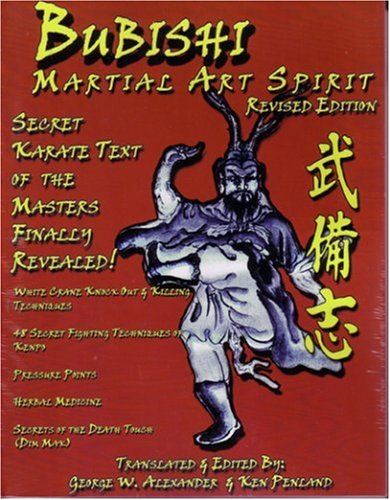
The “Ogura-print-edition”, translated and edited by George Alexander and Ken Penland under the name of “Bubishi: Martial Art Spirit.”
So I got this book and it’s a big soft cover with a depiction of the Buasaganashi on the front (clearly from Miyagi/Higa lineage). On page viii the authors thank “Master Tsuneyoshi Ogura, 10th Dan Goju Ryu Karate for providing his original version of the Bubishi.” So the authors received an – I guess handwritten – edition from the possession of Tsuneyoshi Ogura. This they translated and also used the illustrations. For this reason I will refer to this book by Alexander and Penland from here on as the “Ogura-print-edition.”
On first perusal I noticed a few things, which I summarize here.
- The Ogura-print-edition presents 32 articles from “the Bubishi.” Many illustrations are traces from the Mabuni 1934 book, others not. All in all the illustrations are naive and inartistic in their implementation.
- The Ogura-print-edition contains 48 two-person drill illustrations, which are without exception styled after the Mabuni 1934 book; this is surprising, as the Mabuni 1934 book has only 28 two-person drill illustrations.
- The 32 articles of the Ogura-print-edition are not from “the original Bubishi”, but are a collection from various Bubishi edition lineages. This can be seen in the fact that the Mabuni 1934 book has only 11 articles. Bubishi parts from the Miyagi/Higa lineage Bubishi, which has 29 articles, were clearly used in Ogura-print-edition. For instance, this can be seen in the two illustrations of the Busaganshi: one from the Mabuni edition, one from the Miyagi/Higa lineage editions.
- Drawings of meridians in the Ogura-print-edition were taken from another printed book. They are based on the meridian charts first produced by Hua Shou (1304-1386).
- Drawings of plants in the Ogura-print-edition are also from another printed book.
- There is no photo of the handwritten Ogura original, no word of greeting, nor an explanation when, how, and where it was borrowed and copied.
- The Ogura-print-edition uses Wade-Giles or a similar system of phonetic transcription, instead of the official Hanyu Pinyin. In this way, Cheung Shiu Shu instead of Zhen Chishu, Fang Chi Liang instead of Fang Qiniang, Chi instead of Qi etc. At the same time Japanese terms are used, like Kenpo instead of Ch’uan-fa (Quanfa). The designations for the Chinese 12-hour system are given in Japanese, too (ne, ushi, tora, etc.). Regional dialects are also used, like Dim Mak, Dim Hsueh, Dim Ching. That is, it is not consistent in its transcription method.
As anyone can see, there are some points that are rather conspicious. So before I could make a statement about the originality of this Ogura-print-edition, I had to look a little closer.
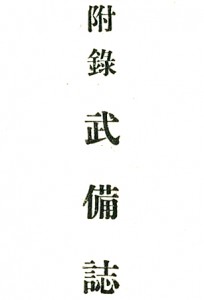
“Furoku Bubishi”, or “Attachement: Bubishi”, from Mabuni’s 1934 book.
Looking for clues as regards the original documents used by Ogura to compile his edition of the Bubishi, the first thing to note in the present Ogura-print-edition is that on the starting page of each chapter a picture with Japanese characters accompanies the headline. The characters say “Furoku Bubishi”, i.e. “Attachement: Bubishi.” This very specific name is the header of the Bubishi appendix of Mabuni’s 1934 book and has been reproduced here.
So it seems very obvious here that Ogura used this book by Mabuni Kenwa, which is nothing else but:
Mabuni Kenwa: Kōbō Jizai Karate Kenpō. Sēpai no Kenkyū. Tōkyō, Karate Kenkyūsha Kōbukan 1934.
So far so good.
So this was one of the sources Ogura used. Next I stumbled over something revealing. In Chapter 4, “The Teachings of the Old Poems,” on page 8 of the Ogura-print-edition an error occurred: The caption of the illustration shown on this page says “old poem referenced by the Bubishi.” But in fact the picture shows something completely different: namely publication data of the Chen Shan Mei Publishing Co. from page 2 of the 1959 Taiwan pirate edition of Mabuni Kenwa’s above mentioned work.
Obviously the translators didn’t notice this. See below 1) the page in the Ogura-print-edition, 2) magnification of the picture, and 3) the original page on page 2 of the 1959 Taiwan pirate edition of Mabuni Kenwa’s above mentioned work.
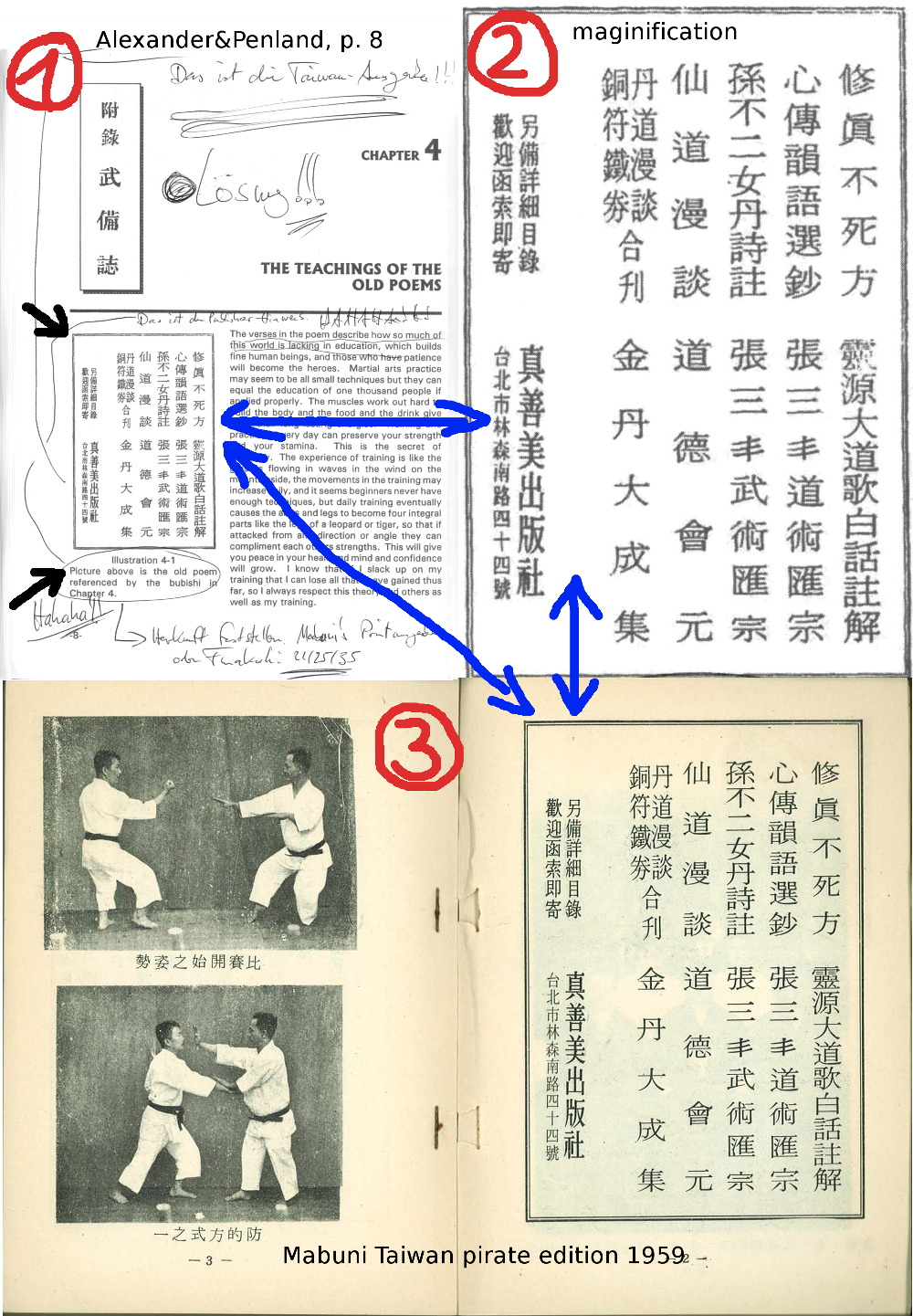
Illustration “old poem referenced by the bubishi”, which in fact shows publication data found on page 2 of the 1959 Taiwan pirate edition of Mabuni Kenwa’s 1934 work.
So what does this mean? Of course, it means that the Mabuni edition used by Ogura was not Mabuni’s 1934 original book, but a pirate edition of it published in 1959 in Chinese language by Taiwan based publishing company Chen Shan Mei Publishing Co. The bibliographic reference for this book is:
Mabuni Kenwa (Author) und Mo Qingli (Translator): Goshin-jutsu Hiden Karate Kenpō. Zhenshanmei Chubanshe, Taipei, 1959.
It is therefore decidedly clear that the Ogura-print-edition made use of the 1959 Taiwan pirate edition of Mabuni’s work. Furthermore, it can be concluded that all 11 articles from this edition had been used, and of course, the illustrations.
It is important to note here again that the Mabuni editions of both 1934 and 1959 only contain 28 two-person drill illustrations. According to Mabuni himself these originated in Itosu Ankō’s handwritten Bubishi edition. But the Ogura-print-edition features 48 two-person drill illustrations, that is, 20 more than Mabuni. But these, too, all show the very distinctive and unmistakable features of the Mabuni illustrations of 1934 (1959).
So, does this mean that the Itosu Ankō edition originally included all 48 scenarios, that Mabuni only published 28 of them, and that the Ogura-print-edition is the only one edition known so far that ever presented these in full??? Thus making it the most “original Bubishi” in existence?
Very decidedly: no!!! The number of 48 two-person drill illustrations is only found in the Miyagi/Higa lineage Bubishi.
So the question is: Where did the 20 extra illustrations in the Ogura-print-edition originate from?
The 48 two-person fighting scenarios
First of all, the Ogura-print-edition used the intersection of the Miyagi/Higa lineage Bubishi with its 29 articles, plus the difference quantity of 3 articles found in other editions, namely from among the 11 Mabuni articles, thus came up with 32 articles.
The number and sequence of the 48 two-person-drills of the Ogura-print-edition match 100% with that of the various Miyagi/Higa lineage editions, such as Fukuchi Seikō edition and Ōtsuka Tadahiko editions. But the Mabuni 1959 edition, which was used for the Ogura-print-edition, only has 28 two-person-drills which are in a complete different order. Notwithstanding, all 48 two-person-drill illustrations of the Ogura-print-edition sport the unique and unmistakable features of the Mabuni illustrations.
So, as Mabuni only had 28 two-person drills, the question posed itself if they are a subset of the 48 two-person drills, and if yes, which ones exactly?
In order to establish an answer, I created the following register. In it the sequence and numbers of the 28 two-person drills of the Mabuni edition (Itosu lineage Bubishi) were compared to the 48 two-person drills Ogura-print-edition (Miyagi/Higa lineage Bubishi).

Here we clearly see that all 28 two-person drill illustrations of the Mabuni edition (Itosu lineage Bubishi) match with certain numbers of the 48 two-person drill illustrations from the Ogura-print-edition (Miyagi/Higa lineage). For example, Ogura No. 3. corresponds to Mabuni No. 13, Ogura Nr. 10. corresponds to Mabuni No. 21. and so on. Obviously, the Mabuni edition not only had a different numbers, but also a different order. But now we can compare these.
Furthermore, we also see which exact numbers of the Ogura-print-edition (Miyagi/Higa lineage) were not covered by the Mabuni edition (Itosu lineage Bubishi) as a model. From this we derive two new tables, namely: 1) the 28 matching two-person-drill illustrations, and 2) the remaining 20 two-person-drill illustrations.
1) The 28 matching two-person-drill illustrations
The numbers of the Ogura edition can now be assigned to the numbers of the Mabuni edition in a comparison register as follows.

Comparing the 28 matching two-person-drills in the Ogura and the Mabuni print editions, it gets decidedly evident that the Ogura illustrations are traces of the Mabuni edition, be it electronically or by hand.
In fact, the meticulous comparison of the 28 matching two-person-drills of Mabuni and the Ogura-print-edition shows a 100% match in distances, finger positions, beards, hairstyles and even facial wrinkles and other unmistakable details.
Sometimes the black gauntlets were assigned to the wrong fighter, but that’s about it with the differences. That means: Without the slightest doubt: the Ogura-print-edition features the traces of the 28 scenarious taken from Mabuni. And as we have seen before, it was the 1959 pirate Taiwan edition of Mabuni‘s that was used here. Here follow just two examples. You should closely compare distances, positions of fingers, arms, foot positions, trower folds, rips, navels, hairdo etc.
Example 1: 30: 143 (4: 151).
This comparison shows that illustration number 4 (page 151) of the Mabuni edition (left half of below’s picture) was used to retrace Ogura’s number 30 (page 143, right half of below’s picture). The correspondence is 100 %.
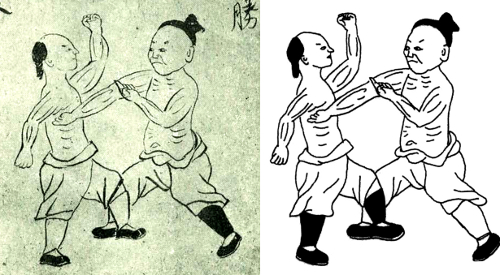
Example 1: 30: 143 (4: 151).
Example 2: 38: 151 (6: 153).
This comparison shows that illustration number 6 (page 153) of the Mabuni edition (left half of below’s picture) was used to retrace Ogura’s number 38 (page 151, right half of below’s picture). The correspondence is 100 %.
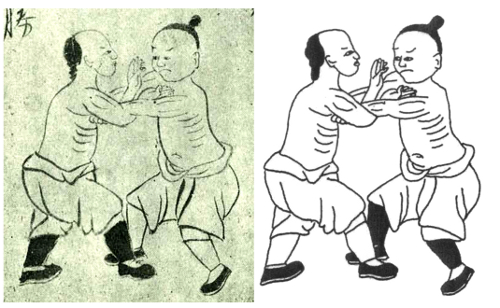
Example 2: 38: 151 (6: 153)
Just like in these two examples, all of the 28 two-person drills found in the Mabuni edition have been traced and used in the Ogura-print-edition in exactly the same manner.
So far, so good.
2) The 20 remaining illustrations
I spare you the next table. You can easily derive it from the first register given above.
All 48 two-person drills illustrations in the Ogura-print-edition exhibit the unique features and style of the 28 Mabuni illustrations. The Mabuni illustrations came from an Itosu edition and only these 28 two-person illustrations are verified to have existed ever, anywhere.
So the question is: Is the Ogura edition the only one that has 48 two-person illustrations from the original Itosu Bubishi?
To anticipate the result: Decidedly nope!
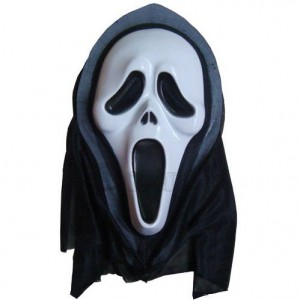 So where did the 20 remaining two-person illustrations in the Ogura-print-edition came from? To anticipate the result again: it can and has been determined. The 20 remaining two-person illustrations in the Ogura-print-edition were produced by using fragments from the 28 two-person drill illustrations of the Mabuni edition, that is, upper bodies, lower bodies, arms, heads were used as fragments. Some parts were also simply mirrored horizontally to fit in a specific number.
So where did the 20 remaining two-person illustrations in the Ogura-print-edition came from? To anticipate the result again: it can and has been determined. The 20 remaining two-person illustrations in the Ogura-print-edition were produced by using fragments from the 28 two-person drill illustrations of the Mabuni edition, that is, upper bodies, lower bodies, arms, heads were used as fragments. Some parts were also simply mirrored horizontally to fit in a specific number.
Now, you may ask, where did the templates for these 20 remanufactured Mabuni-style figures came from? How did “Ogura” know how they look like when they were not featured in the Mabuni edition? That’s a good question. But as I have previsouly pointed out, the Ogura edition used a Bubishi from the Miyagi/Higa lineage, which all have the complete 48 two-person illustrations. So far it has not been determined which edition exactly it was but that actually doesn’t matter. Because it’s the only lineage in which the 48 two-person-drill illustrations could be verified.
So, without any doubt, “Ogura” used a handwritten Bubishi from the Miyagi/Higa lineage, and this was used to provide for the templates to remanufacture the remaining 20 two-person-drill illustrations in a Mabuni-style, which lay before us now in the Ogura-print-edition of Alexander & Penland.
Let’s look at the remanufactured Mabuni-style 20 two-person-drill illustrations. The 20 remaining numbers from the Ogura-print-edition, which are not found in the Mabuni edition nor anywhere else, have been determined previously and I use the already established register again now.
The left column gives the number of illustration of the Ogura-print-edition, followed by the page number. The next two columns give the origin of the illustration or parts of it that have been determined. The reference number in these two columns again gives the number and page number at Ogura, followed by number and page number of Mabuni in brackets. I chose to only present some of the most obvious matches, but all 20 two-person-drill illustrations follow the pattern shown here.
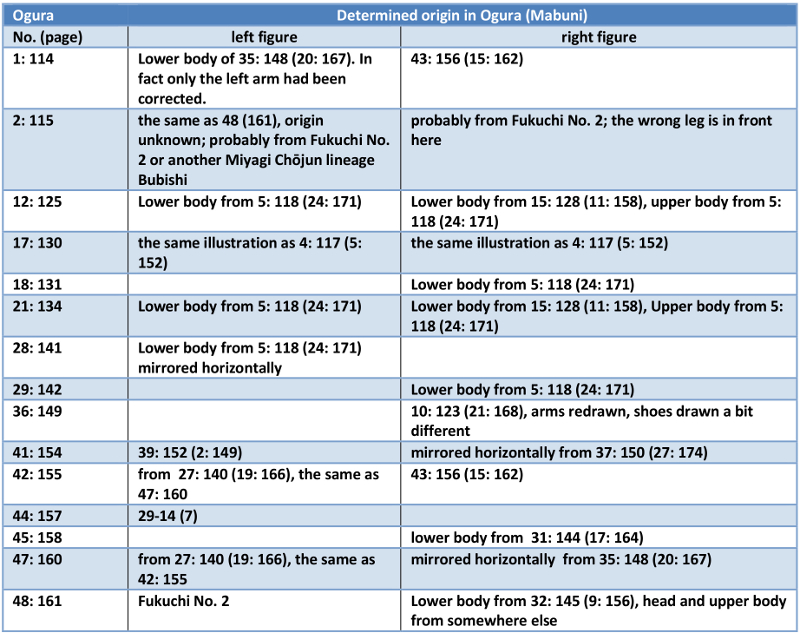
The comparison brought to light that the largest part of the figures in the 20 remaining two-person-drill illustrations not covered in the Mabuni edition have been assembled in the truest meaning of the word from fragments of exactly these 28 two-person illustrations of Mabuni. By fragments I mean upper bodies, lower bodies, arms, heads from the Mabuni edition were used. In this way these 20 two-person-drill illustrations perfectly imitate the “Mabuni-style” (Itosu Bubishi). But as these 20 two-person-drill illustrations do not exist in any verified edition, they were assembled from original fragments, by using the templates from a different source edition, using their forms and accompanying texts. Namely, this was a Bubishi from the Miyagi/Higa lineage.
The above was decidedly and methodically established here as a fact. It is of little use to provide the complete analyzis here, but you might check it yourself by using the register given above. Instead I simply provide the following two examples.
Example I: 1: 114 – left figure.
This comparison shows that illustration number 20 (page 167) of the Mabuni edition (left half of below’s picture) was used to construct Ogura’s left figure in number 1 (page 114, right half of below’s picture), which is not found in the Mabuni edition. Only the arms were adapted.
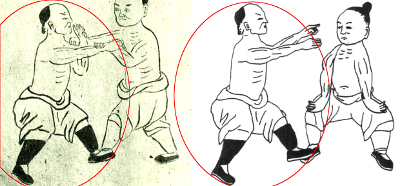
Example I: 1: 114 – left figure.
Example I: 1: 114 – right figure.
This comparison shows that illustration number 15 (page 162) of the Mabuni edition (left half of below’s picture) was used to construct Ogura’s right figure in number 1 (page 114, right half of below’s picture), which is not found in the Mabuni edition. Only the arms were adapted.
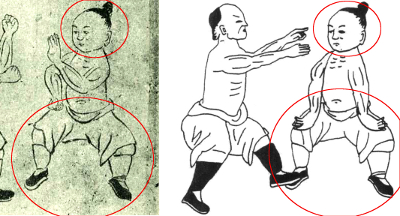
Example I: 1: 114 – right figure.
Example II: 12: 125 – left figure.
This comparison shows that illustration number 24 (page 171) of the Mabuni edition (left half of below’s picture) was used to construct the lower body of Ogura’s left figure in number 12 (page 125, right half of below’s picture), which is not found in the Mabuni edition. Only the arms were adapted, and the belly and chest as the left arm of the figure was taken away in the retouche.
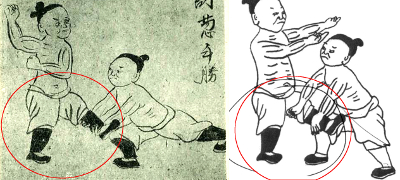
Example II: 12: 125 – left figure.
Example II: 12: 125 – right figure.
This comparison shows that illustration number 11 (page 158) of the Mabuni edition (left upper half of below’s picture) was used to construct the lower body of Ogura’s right figure in number 12 (page 125, right upper half of below’s picture), which is not found in the Mabuni edition.
The upper body of Ogura’s right figure was constructed by number 24 (page 171 ) of the Mabuni edition (centre lower part of below’s picture). Only the arms were adapted to extend over the legs.
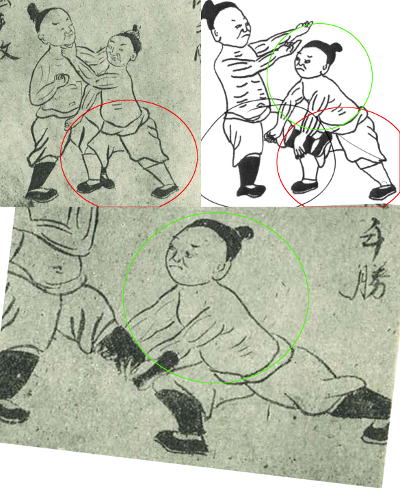
Example II: 12: 125 – right figure.
I could go on and on with my analysis. As I already noted in the beginning, the drawings of meridians in the Ogura-print-edition were taken from another printed book and are based on the meridian charts first produced by Hua Shou (1304-1386). The drawings of plants in the Ogura-print-edition are also from another printed book. The following two illustration, besides lackig any artistry, are also (horrible) reworks from Miyagi/Higa lineage editions: Article 27 (Zheng’s Twenty-Four Iron hand Applications and White Monkey Style) and Article 28 (Eighteen Scholars White Crane Fist and Black Tiger Style Fifty-Four Step Quan).
Furthermore, the same identical trace of Mabuni’s 36 vital point diagram (Mabuni 1934/1959, page 142) were simply reused for 3 different articles of the Ogura-print-edition. See the following comparison:
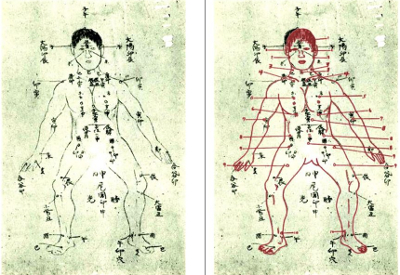
In three different articles the Ogura-print-edition uses the same illustrations, which is a picture traced from Mabuni’s 36 vital point diagram. Left side: Original, right side the Ogura trace placed over it in red (Cf. Mabuni page 142; Ogura-print-edition 20, 27, 105)
3 articles only found in the Mabuni edition and not in other lineage editions were incorporated into the Ogura-print-edition. The three article are:
- Article 31 on Shaolin Herbal Remedies.
- Article 32, which shows the “Shaolin Temple Fist and Leg Formal Excercises.” All the 34 illustrations here were likewise traced from the Mabuni edition.
- Article 22 on “The Delayed Death Touch and Twelve Hour Dragon Breath Time Charts.” All 12 illustrations here were also traced from the Mabuni edition.
Besides, Article 20. on “The Six Wind Hands of the Shaolin System” were also traced from the Mabuni edition.
Conclusion
The Ogura-print-edition translated and edited by Alexander & Penland is very decidedly not an original work. Instead, it is a compilation of partial copies and partly forged illustrations. The illustrations are simply quite horrible, artless works, without any originality. If the same thing happened with the Kata of Karate and Kobudo, well then good night. Most importantly, 20 of the 48 two-peron-drills do not show the original positions etc. Accordingly they cannot be called “original illustrations” and might as well lead into a wrong direction. To state one more example: In Ogura number 2 on page 115 the wrong leg is in front. How will you ever be able to even get close to something like an “original application” here?
As regards the Amazon customer reviews, talking about “the most complete and acurate translation available” of “the original text”, I am totally unsure, too, and I tell you why. As it turned out, Ogura used the 1959 Taiwan pirate edition of Mabuni. This edition had been written in Traditional Chinese. The translator had the printed texts newly set and also added his own interpretations. In doing so, not only punctuation marks have been altered or supplemented, but whole headings or sub-headings were changed, shortened or completely rewritten. The following are just some examples showing the differences in the Taiwan issue (highlighted in red) as compared to Mabuni’s original edition:
 In addition, different characters and often even completely changed sentences were used. Take as an example the following from Article 11 (Sun Wǔzǐ Yun, p.176) of the Mabuni edition. The differences in the Taiwan issue are marked in red:
In addition, different characters and often even completely changed sentences were used. Take as an example the following from Article 11 (Sun Wǔzǐ Yun, p.176) of the Mabuni edition. The differences in the Taiwan issue are marked in red:

Finally, the characters and units in the articles on herbal medicines were changed to a modern written designation. The classical Chinese text of the Mabuni original, both in headlines as well as in the text itself, was massively changed in the Taiwan edition.
In other words: as regards the complete and “original text” it should be kept in mind that any translations made from the 1959 Taiwan edition are questionable already from their source. This might also clear up some irritations as regards differences in different translations and the question “which is the original Bubishi text?”
Apart from this: If Ogura in his text worked in a similarly liberal and imprecise fashion as he did in the illustrations, then I am afraid the veracity of this translation must seriously be doubted, no matter what impeccable Budo Spirit and good intentions the translator and editor placed into this work of publishing an Ogura-print-edition under the name of Bubishi: Martial Art Spirit at Yamazato Publications.

The “18 hands of the vagabonds”, from the original Bubishi.
© 2015, Andreas Quast. All rights reserved.